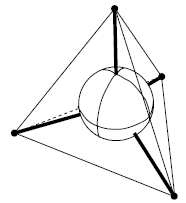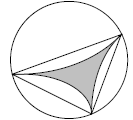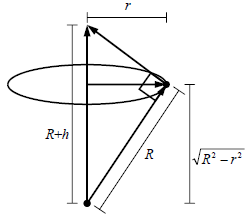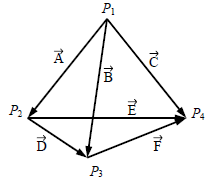circle
It is easy to see that the minimum number of posts
required is 4. This is because any single light
post will fail to illuminate some great circle. (Imagine that the light post is
at the north pole and
the great circle is the equator.) From that point, it is not possible to
illuminate that great circle
with less than three additional posts.
The simplest solution, and almost certainly the one with the shortest total post
length, comes
from placing the posts at the corners of an inscribed regular tetrahedron as
illustrated in Figure 1.
This gives us a total lamppost length of 8R where R is the radius of the planet.
The trick is to
prove that this is the minimum length. To do this, we make one clever
observation and then use
brute force.
Any minimal lighting solution must correspond to the case of a (not necessarily
regular)
tetrahedron inscribed in the circle (this is not the inscribed tetrahedron
described in the last
paragraph). This is because the light from a single post creates a circular
patch on the sphere that
must contain the “triangular” region given by the space not covered by the other
posts. The
minimum post height comes from minimizing the radius of the circle to the one
that contains the
three corners of the triangles. The light pattern appears as in Figure 2 below.
We are working in the case of four points at random on a sphere given by x2 + y
2 + z 2 = 1. For
any face of the tetrahedron, we can find a circumscribed circle. The lamppost
height
corresponding to that circle is given by similar triangles as illustrated in
Figure 3. We see that the
height of the can be found with the help of the ratio

It will be given by the formula

where h′ = h / R and r′ = r / R . At this point, we will
just assume a sphere of unit radius. We
make use of the past Puzzle Corner where it was shown that the radius of a
circumscribed circle
for a triangle with sides a, b, and c is given by

where K is the area of the triangle. If we use the vectors
as given in Figure 4, then the formula
for the areas of those triangles will be given by
 etc. This gives us a final formula of
etc. This gives us a final formula of

The brute force part comes from generating random
inscribed tetrahedrons and determining the
post length that they correspond to. We are solving the problem by throwing
darts at it. We pick
the points (without loss of generality, we may pick one point to be the north
pole and one point
to be on the x-axis) and check to make sure that the center of the sphere is
contained in the
tetrahedron. If it is, we measure the post heights. For instance, for 1,000,000
sets of throws, we
get a minimum height of 8.0497001 and the number of values distributed (for each
of 10 equal
intervals) between 8 and 9: 3,9,21,32,47,62,77,88,90,117. This is a clear
indication that the
minimum is at 8 (well, clear enough for me).
Figure 1: The minimal lighting solution. The sphere is inscribed in a regular
tetrahedron. The
bases of the posts are the corners of an inscribed regular tetrahedron (not
shown).

Figure 2: The unlit “triangle” and its circumscribed circle.

Figure 3: Similar triangles giving the relationship
between the radius of a circle (on the surface
of a sphere) and the minimal lamppost height required to illuminate it.

Figure 4: Illustration of the vectors used in Eqn. 4. The
points  all lie on the surface of a sphere
all lie on the surface of a sphere
with radius R.



